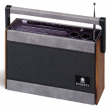
|
||||||||||||
|
|
Radio Waves
Radio waves are a type of electromagnetic radiation with wavelengths in the electromagnetic spectrum longer than infrared light. Like all other electromagnetic waves, they travel at the speed of light. Naturally-occurring radio waves are made by lightning, or by astronomical objects. Artificially-generated radio waves are used for fixed and mobile radio communication, broadcasting, radar and other navigation systems, satellite communication, computer networks and innumerable other applications. Different frequencies of radio waves have different propagation characteristics in the Earth's atmosphere; long waves may cover a part of the Earth very consistently, shorter waves can reflect off the ionosphere and travel around the world, and much shorter wavelengths bend or reflect very little and travel on a line of sight.
Radio waves have the longest wavelengths in the electromagnetic spectrum. These waves can be longer than a football field or as short as a football. Radio waves do more than just bring music to your radio. They also carry signals for your television and cellular phones.
The antennae on your television set receive the signal, in the form of electromagnetic waves, that is broadcasted from the television station. It is displayed on your television screen. The most common radio band names and their corresponding wavelengths/frequencies are:
Cable companies have antennae or dishes which receive waves broadcasted from your local TV stations. The signal is then sent through a cable to your house. How Radio Communication WorksSound and radio waves are different phenomena. Sound consists of pressure variations in matter, such as air or water. Sound will not travel through a vacuum. Radio waves, like visible light, infrared, ultraviolet, X-rays and gamma rays, are electromagnetic waves that do travel through a vacuum. When you turn on a radio you hear sounds because the transmitter at the radio station has converted the sound waves into electromagnetic waves, which are then encoded onto an electromagnetic wave in the radio frequency range (generally in the range of 500-1600 kHz for AM stations, or 86-107 MHz for FM stations). Radio electromagnetic waves are used because they can travel very large distances through the atmosphere without being greatly attenuated due to scattering or absorption. Your radio receives the radio waves, decodes this information, and uses a speaker to change it back into a sound wave. An animated illustration of this process is given below (mouse-over the images for animations).
Credit:NASA, ESA, The National Radio Astronomy Observatory |














